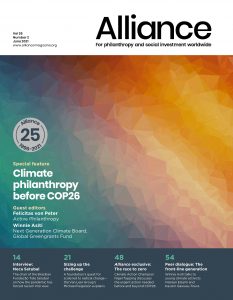‘Philanthropy is incredibly influential.’
That is the view of Nigel Topping, High-Level Climate Action Champion for the UK, who is responsible for driving the actions of non-state actors to a fossil-free future ahead of COP26 in Glasgow this November.

Nigel Topping
According to Topping, who shared his thoughts in an interview with Alliance guest editors, Felicitas von Peter and Winnie Asiti, philanthropy has some of the most informed voices when it comes to climate. Professionals like CIFF’s Kate Hampton and ECF’s Laurence Tubiana are a key source of advice for government ministers – and Topping’s role as the High-Level Climate Champion role depends, in part, on philanthropic backing.
But Topping also had clear views on areas for improvement well beyond the almost universally agreed need for philanthropy to increase its spending from current 2 per cent level.
The key areas ranged from transparency of foundations investments, engagement with the private sector and questions of good climate funding practice.
Transparency with investments
It was striking to hear Topping’s unequivocal view that said there should be greater disclosure of where foundations invest their assets.
‘Every foundation concerned about climate change should be completely transparent about its portfolio’, he argued.
A push for transparency could have significant implications for philanthropic sector especially if the case for a ‘climate action tracker’ for foundations – already in use to hold governments to account – gains traction.

Topping said that he’d like to see ‘about 75 per cent’ of climate funding directed to the Global South.
However, he stopped short of calling on foundations to divest their assets from fossil fuels saying that ‘the question of divestment is more complicated’ because oil companies offshore experience, risk management appetite, and project engineering ‘could make them part of the transition’. ‘There is a case to be made for engagement,’ he noted.
That will disappoint divestment campaigners such as the Wallace Global Fund, though Topping did note that there is a ‘very strong case for divestment of egregious, non-engaged firms, not just in the hydrocarbon sector but also steel, cement, automotive, other sectors that are huge drivers of emissions.’
It seems likely that how one defines what constitutes ‘engagement’ and the threshold for acceptable levels of engagement is set to become hotly debated in the philanthropy sector and beyond.
Read more: Controversial UK coal mine will never happen, says COP Climate Champion
Cross-sector collaboration
Topping also used his interview to highlight opportunities for philanthropic funders to partner with and influence the private sector but noted some cultural reluctance among philanthropic funders.
‘One challenge is that a lot of the levers are now in the private sector and quite a lot of philanthropy is allergic to investing in anything associated with the private sector. But the logic that we need to invest philanthropy in changing policy but not in business or investors doesn’t stand up to scrutiny. I would really encourage them to look at initiatives which are working to transform business, or investors like Share Action, or the Climate Group or Climate Disclosure Project; they’re doing amazing work but are not as well-resourced as some of the conservation types.’
No ‘silver bullets’ in climate funding
Meanwhile, issues of what makes good and effective funding practice have been much debated in our own field of late with renewed calls for long term un-restricted funding and a shift to a more trust-based philanthropy. As far as climate funding goes, Topping’s call for funders to avoid solutions that look deceptively simple is likely to be well-received by funders and grantees alike.
‘One of the problems we have is the search for silver bullets, which tends to lead to fragmented and short-term funding.’
Every foundation concerned about climate change should be completely transparent about its portfolio.
Instead, he urged funders to learn the ropes by supporting intermediary, regranting bodies like the Climate Works Foundation. ‘Do that and learn for two or three years before trying to branch out,’ Topping advised.
A global vision requires global voices
And finally, there are challenges closer to home which philanthropy should be well placed to help out with. Specifically, how should the critical Climate Champion role – which galvanises all non-state actors – itself be funded as the position shifts to Africa under an African COP presidency in 2022.
In answer to a question from guest editor, Felicitas von Peter, Topping said that he’d like to see ‘about 75 per cent’ of climate funding directed to the Global South. That would require ‘systemic change thinking from philanthropists, rather than trying to find the project.’
Whether northern and southern climate funders will come together to place a High Level Climate Action Champion in Africa on a secure financial footing for the next 5-10 years, as Topping hopes, may prove an early test of of philanthropic ambition when it comes to stopping our planet over-heating.
Charles Keidan is Executive Editor at Alliance.
 New issue: Climate philanthropy before Glasgow
New issue: Climate philanthropy before Glasgow
A follow up to our June 2016 issue ‘Climate philanthropy after Paris’, this issue looks at philanthropy’s role in addressing climate change as we approach the world’s pivotal climate summit five years on: COP26 in Glasgow. Guest edited by Global Greengrants Fund’s Winnie Asiti and Active Philanthropy founder, Felicitas von Peter.
Read the full interview with Nigel Topping, published in the issue.






Comments (0)